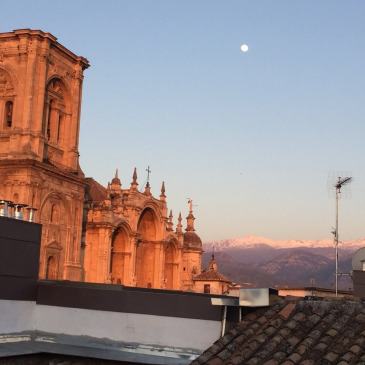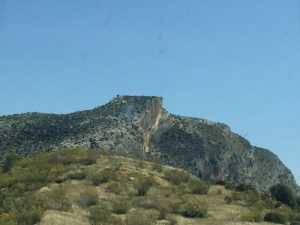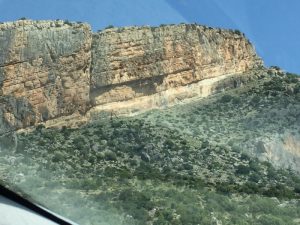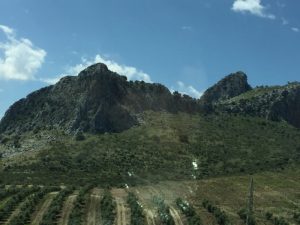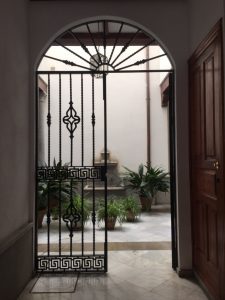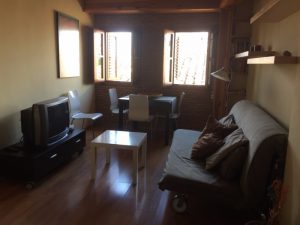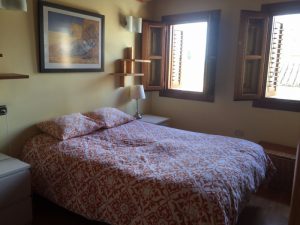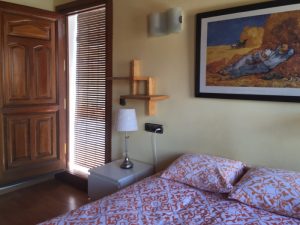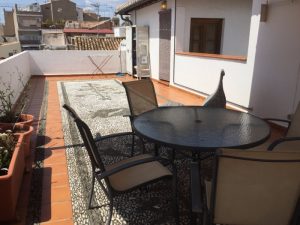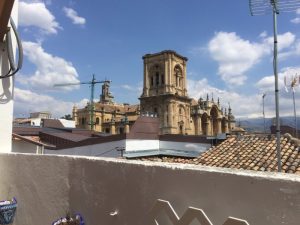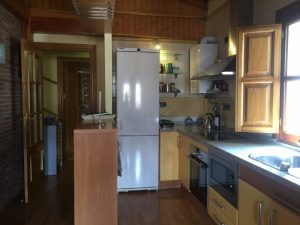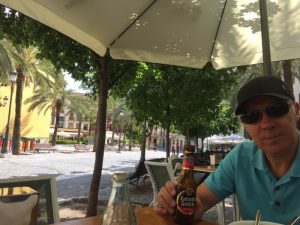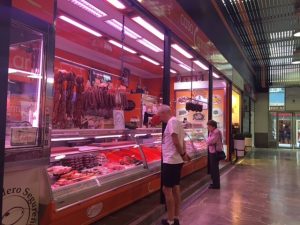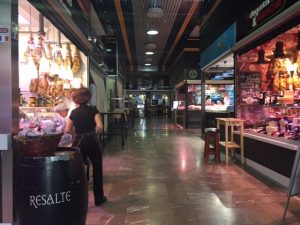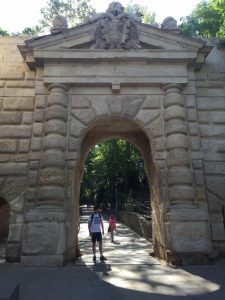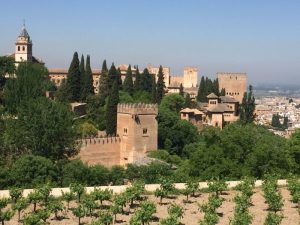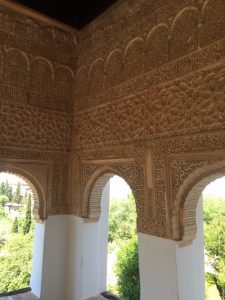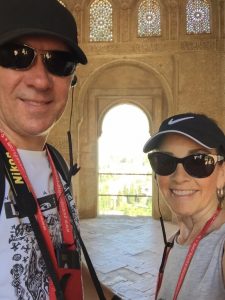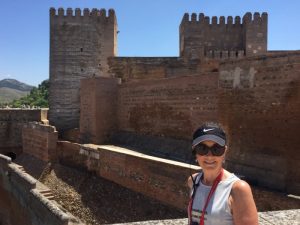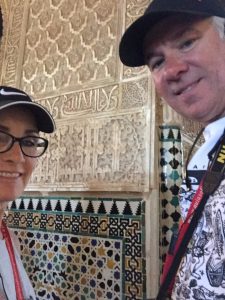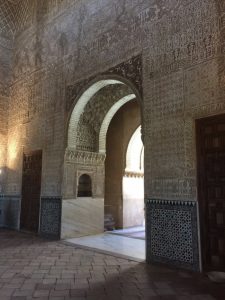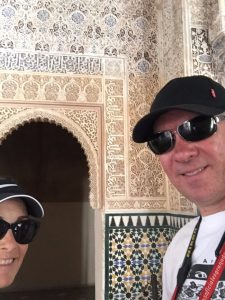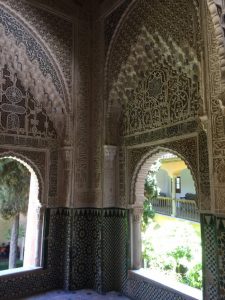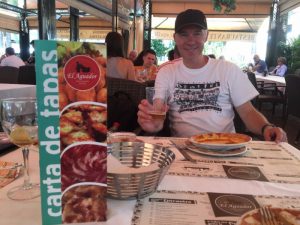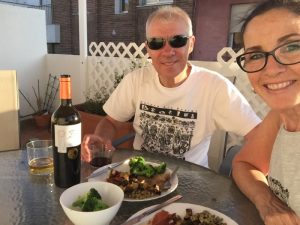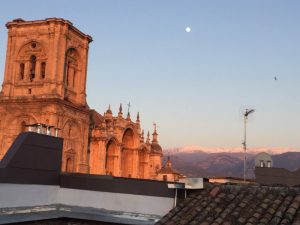Wednesday 18th May: Drive to Granada Day.
http://www.vrbo.com/433332ha#
We had a final walk through Ronda before heading off for the 2 hour drive to Granada and the weather was good making for a relatively easier drive.
The scenery between Ronda and Granada is quite varied and spectacular in parts with pretty mountains, the odd exposed geological uplift, rolling fields of olive farms and then some occasional flat areas of wheat.
It was a bit of a navigational challenge to drop our bags off at our next lodging though as this was an apartment situated in the pedestrian-only part of the Old Town but it all worked out in the end. Our lodging for the next three nights is a lovely 1 bedroom apartment on the 4th floor of a traditional Spanish building where the room, apartments, radiate off an open central courtyard. Ours is the only apartment on the 4th floor and it has a lovely large roof terrace with views of the Granada Cathedral which just happens to be right next door. Looking out beyond the Cathedral we are then granted a splendid view of the snow-capped Sierra Nevada mountains off in the distance!
We dropped our bags and then went off to find the local El Corte Ingles department store to pick up some food supplies before then heading back to visit the Cathedral. The Granada Cathedral was ok and worth the visit but we’re beginning to rank all Cathedrals now in order of their impressive quality and we’ve seen so many Cathedrals we feel quite well equipped to carry out this task. The Granada Cathedral, however, was less impressive than some others we had seen on this trip. The audio-guide took about 30 minutes to complete but we also think we could re-draft this one, and many of the others as well, for the Spanish Tourist Bureau too. The audio guide was simply a list of dates and names and had nothing by way of juicy or interesting anecdotal information. We left the Cathedral and strolled around the local area, noting how lively the whole place was, before heading back to the apartment to have dinner on our terrace. Gelato beckoned after dinner though and so we stepped out our door into a rather festive atmosphere and strolled through a few plazas whilst sampling their attempts at gelato which was not as good as what we get at home.
We are both liking Granada more than Seville but do wonder if this is a function of the weather. We’ve had good weather for our first day in Granada and rain for much of the time in Seville so we’re open-minded to that possibility. However, Granada feels more sophisticated than Seville and much more like Rome but without as many tourist traps. I’d definitely add this to your ‘to do’ list if you haven’t been here already.
Thursday 19th May: Alhambra tour day.
The plan for the day was to take a 3 hour guided tour of the Alhambra at 11.30 am. We fitted a walk in before this and came across the San Agustin Markets which is a great mix of shops including a bakery, butcher, delicatessen, cafes and restaurants all rolled into one neat space under the one roof. Mark bought a few items to add to our dinner menu for tonight.
The Alhambra is the most visited tourist attraction in Spain and tickets need to be purchased well in advance. I’d bought our tickets over 6 weeks ago and, even then, struggled to get a slot. The history of the Alhambra is that it was a Moorish fortification built during the 13th Century on the site of a previous fortification that dated back to the 8th Century. This was not the first Moorish settlement in Granada though as the oldest Moorish settlement dates back to the 8th Century in the Albayzin area, where we are visiting tomorrow. However, in the 13th Century there was an influx of Nazrid Moors to Granada, who were originally from Morocco, and they settled in the Alhambra area due to its higher vantage point for obvious safety reasons.
It was another sunny day making for ideal conditions to visit the Alhambra but it meant we were rather warm by the time we had walked the 30 min trip up the hill to the tour meeting point. We entered through the ‘Pomegranate Gate’ which was a much later addition commissioned by King Charles 5th during the 16th century. The Spanish word for ‘pomegranate’ actually translates as ‘Granada’ and the gate has three large pomegranate sculptured into the stone.
The Alhambra covers a vast area and we visited four main parts during our 3 hour tour: Firstly, the Generalife, which was built as a summer palace for the Nasrid Moorish Kings. Secondly, we went into the Medina where we saw the Old Mosque which was converted to a Church during the re-conquest period, and the old Moorish baths. Thirdly, we visited the Alcazaba, or main Fortress of the Alhambra, and finally, we went through three former Palaces that retained much of their original structure and layout. Some of the other Palaces are in fairly ruinous condition and being restored and one other was converted to a 5-star hotel!
Like so many other Moorish areas we have seen along the trip, the Alhambra succumbed to the Christian re-conquest in 1492 and eventually fell into ruin when the Christians expelled the Muslims. Without the Muslims present to pay taxes to the Christians the area started to suffer. Many parts of the Alhambra suffered serious deterioration as the buildings were left vacant for many years and to simply decay whilst Gypsy activity also resulted in a lot of the internal structures being damaged. However, nowadays, the whole site is a UNESCO World Heritage site and under strict control with a lot of restoration work in progress.
It was 3 pm by the time we left the Alhambra and we caught the bus down the hill to have a tapas lunch in the same plaza as yesterday, Plaza de la Romanilla, but at a different restaurant and from there we headed back home for a bit of a rest. At around 6pm we headed out to take the small shuttle bus tour through the city, much like the Open Top bus tours present in other cities. This small shuttle bus was designed especially for the narrow lanes throughout the Old Town. We then headed back to the apartment for a night of dining in.
